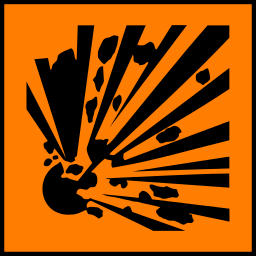Home | Explosive Safety | Blast Mining | Explosives list
Explosive Safety
Explosives are often seen as inherently dangerous. However, with the correct safety procedures we can eliminate all accidents!
Our staff is trained to handle many different types of explosives and manage a safe work environment.
History
Dynamite was the first modern high explosive. Its active ingredient is nitroglycerine, a sock sensitive, friction sensitive, oily liquid explosive. As dynamite it is desensitised to prevent unintentional detonation. In the modern era, a number of safer explosives where developed.Binary explosives are a class of explosive where two separate chemicals (a fuel and oxidiser) need to be combined before an explosion can occur. This setup means that if the fuel and oxidiser is separated the change of an accidental explosion is basically zero. Other explosives have their oxidiser component inside the same molecule as their fuel.
Most modern storage practises require explosives to be storage in sealed bundles, with space between them. They must be inspected regularly to insure the container isn't ruptured. Some explosives have a minimum required distance from flammable material, and need to be placed inside due to lightning.
Ammonium nitrate
Despite having very low shock and friction sensitivity, ammonium nitrate can be dangerous! Many people without explosive safety experience will interact with this material as it is used extensively in agriculture. Because of this, a number of storage regulations and requirements have been created by regulatory bodies in order to prevent accidents.In Australia, the Department of Mines, Industry Regulation and Safety are responsible regulating the storage of ammonium nitrate.
CODE OF PRACTICE: Safe storage of solid ammonium nitrate Fourth edition
Main section on mine safety

|

|

|